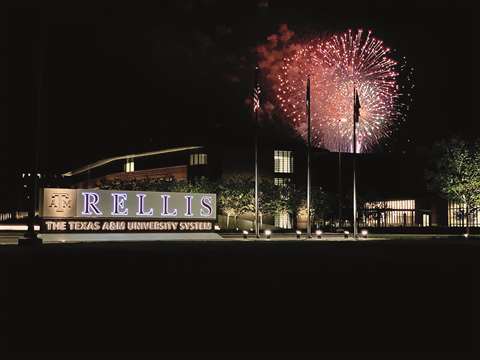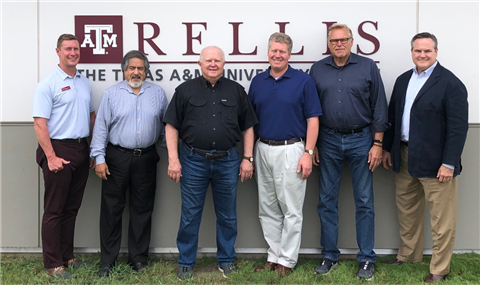ACT EXCLUSIVE: Industry’s first Crane Safety Research Lab
26 September 2022
The crane industry is about to get smarter. And ultimately safer.
In 2023, the Texas A&M Crane Safety Research Laboratory will be launched at Texas A&M University in College Station, TX, American Cranes & Transport exclusively reports. The Laboratory will be a part of the College of Architecture, which includes the study of Construction Science. Located on the new RELLIS Campus, the Crane Safety Research Lab will the first of its kind in the world. A collaboration between academia and industry, the goal of the lab is to make crane operation safer. And to save lives.
 The Texas A&M University Crane Safety Research Laboratory at the RELLIS Campus will bring together academics and industry with the goal to make crane ownership and use safer.
The Texas A&M University Crane Safety Research Laboratory at the RELLIS Campus will bring together academics and industry with the goal to make crane ownership and use safer.
For this project to come to fruition, a lot of stars had to line up. But long-time crane industry veteran Dr. Jim Wiethorn, founder and chairman of Crane Risk Logic, knew it was an idea whose time had come. So how did it all evolve?
In 2014, Dr. Wiethorn, who actually holds a Ph.D. in civil architecture and engineering, had just finished his book and subsequent dissertation about crane accidents. He continued to work on crane accident analytics and was (and still is) a frequent speaker on the topic of his research regarding crane accidents and crane safety. In 2016, a crane accident in New York City brought crane safety back onto center stage. After researching that accident, Wiethorn realized that there needed to be a device to secure a crane during emergency situations, especially in highly congested areas. He designed a device called the Windshoe, which was later patented. He is working on the design of other such devices.
How it evolved
Many of the accidents he had investigated through the years could have been prevented with different types of crane safety devices, and he wanted to be a part of the developing these devices. He started meeting with friends and colleagues in the crane world, including longtime risk management expert Kevin Cunningham and Jimmy Lomma, who was owner of Lomma Cranes in New York City.
In time he would reach out to his academic community contacts, including Dr. Stephen Mulva, who he had worked with at the University of Texas while writing his dissertation. Dr. Mulva had been director of the University of Texas Construction Industry Institute in 2018 when Dr. Wiethorn finished his thesis.
Dr. Wiethorn’s question was this: What if we could create some sort of crane safety institute or lab where crane safety development research could be pursued through an academic avenue?
During the time the idea was germinating, Wiethorn and Lomma formed a company called Crane Risk Logic, a professional engineering based safety, technology and risk consulting practice, and engaged with Cunningham as a risk management advisor. They spent a couple of years discussing what this company could do and offer the crane industry. Lomma’s influence was critical, but sadly he passed away in the summer of 2019.
Over the course of the next three years, Dr. Wiethorn continued his research and developing and testing crane safety devices. He continued discussions with
Dr. Mulva, and they engaged with Cunningham as an advisor to determine potential impact with crane insurance, litigation containment opportunities and various crane safety culture aspects to eliminate catastrophic accidents. In the spring of 2022, the idea of collaborating with an academic institution took a turn. Dr. Mulva changed jobs, taking a professor role at the College of Construction Science at Texas A&M.
 The core leadership team for the new Texas A&M University Crane Safety Research Lab include (from left) Dr. Patrick Suermann, Dr. Jorge Vaneges, Dr. Jim Wiethorn, Dr. Stephen Mulva, Kevin Cunningham and Kelly Templin.
The core leadership team for the new Texas A&M University Crane Safety Research Lab include (from left) Dr. Patrick Suermann, Dr. Jorge Vaneges, Dr. Jim Wiethorn, Dr. Stephen Mulva, Kevin Cunningham and Kelly Templin.
What is the task ahead?
Texas A&M University, world renowned for its work in transportation, infrastructure, space, engineering and all sorts of construction science disciplines, was immediately interested in the idea. Dr. Mulva, Dr. Wiethorn and Cunningham picked up where they left off, and the Texas A&M Crane Safety Research Lab concept started taking root. The university’s College of Architecture (Construction Science) leadership team led by Dr. Patrick Suermann, bought into the idea. In a short time, a business alignment deal was reached, and a master research agreement was formalized.
The team at Texas A&M includes Dr. Patrick Suermann, dean (Interim) College of Architecture (Construction Science); Dr. Jorge Vaneges, vice president, Texas A&M, Academic & Strategic Collaborations; Mr. Kelly Templin, Director, RELLIS Research Campus, and Dr. Mulva, who will be the director of the Crane Safety Research Lab. Wiethorn and Cunningham are also a part of the team.
The task ahead is to establish the research work and eventually bring it to the greater crane and rigging industry.
“The mission of the Crane Safety Research Lab working in conjunction with Crane Risk Logic is simple: to save lives, prevent crane project catastrophe, reduce insurance costs and increase productivity,” Cunningham said. “The joint business model between Crane Risk Logic the new Texas A&M University-based Crane Safety Research Lab contemplates a global scope of operations by crane owners and other associated organizations.”
Texas A&M has a distinguished construction education curriculum, and its students are highly recruited by construction and engineering firms and construction equipment OEMs around the world, including the crane and rigging sector.
The Texas A&M Crane Safety Research Lab will be a part of the university’s RELLIS campus in Bryan, TX. The former air base is being transformed into a mobile field campus for construction and other studies.
Transformative research
The RELLIS campus in itself is an incredible story. Billed as America’s newest center for transformative research and education, the RELLIS campus is a collaborative ecosystem built to foster advanced research, technology development, testing and evaluation, higher education and hands-on career training, according to Dr. Vaneges. RELLIS is currently seeking corporate, government and educational partners for applied research opportunities. RELLIS will facilitate growth in many industries, and research and testing facilities at RELLIS include those for autonomous and connected vehicles, robotics, roadside safety and physical security, advanced manufacturing, large-scale infrastructure, smart power grids and water systems and Internet of things (IoT).
And soon the crane industry will be added to that list.
“This is a coalition of crane owners, OEMs, operators, unions and other stakeholders and Texas A&M as our academic partner,” said Wiethorn. “The intention here is to transform crane safety in a global environment and establish liaisons.”
I recently met on a video call with Cunningham, Dr. Wiethorn, Dr. Suermann, Dr. Vaneges and Dr. Mulva to discuss the launch of the Crane Safety Research Laboratory. The collective excitement of this team was awesome.
“I have been with A&M for 16 years, and I can tell you what we are putting together does not exist in the world,” said Dr. Vaneges. “With a well-defined scope, we will meet this mission. Not one single project can be done without cranes. Vertical and horizontal construction cannot do without cranes. The supply chain depends on cranes. Because of this wide scope, it’s very hard for one discipline or one institution to address this whole breadth. But we have all the ingredients. Texas A&M is a very industry friendly university. Our core values are well recognized, and we will create a safety laboratory at the RELLIS campus. It’s going to be about excellence for all crane operations. We will set the bar high. We will lead and others will follow.”
Vaneges thinks the big focus will be to eliminate crane accidents.
“There’s a cultural shift,” said Dr. Vaneges. “We are moving away from a purely compliance based approach to safety to active risk management and the incorporation of technology. There’s an inflection point, and data science has advanced to the point that we can bring about change. We’ve seen it in commercial trucking with telematics and we will be using telematics data to help in our research. We will be working with the patented technologies by Crane Risk Logic that will impact the crane industry in a number of ways. And we will be doing it in a university setting.”
The nice thing about addressing crane safety issues in a university setting is that it’s a neutral and impartial playground, he said. It’s the concept of being able to look at data and determine what needs to happen before the crane tips over.
“In our discussions, parallels were made to the aviation industry,” said Dr. Mulva.
In the 1980s and 1990s, the aviation industry knew it was dealing with complex and risky issues, and they knew the industry’s mindset was not good enough, he said. Using aircraft simulators and other training and inspection protocols, the airline industry was able to greatly improve airline safety.
“The goal is to leverage the research and students to bring about needed improvement in technology and safety,” said Dr. Suermann. “We are creating something very unique at a flagship university. It’s all about academic and strategic industry collaboration.”
The team stressed that this collaboration will create an opportunity for very diverse people to come together. The common currency is knowledge, Dr. Mulva said.
“We are in the process of creating a vision that will dramatically change the status quo,” said Dr. Vaneges. “We plan to set up a whole new paradigm. This will lead to deployment, constant improvement through real-time operator performance evaluation to transform crane safety cultures worldwide.”
Dr. Patrick Suermann, Dean (Interim) College of Architecture (Construction Science)
Dr. Jorge Vaneges, Vice President, Texas A&M, Academic & Strategic Collaborations
Dr. Jim Wiethorn, Founder and Chairman, Crane Risk Logic
Dr. Stephen Mulva, Director, Crane Safety Research Lab
Kevin Cunningham, Crane Risk Management Advisor
Kelly Templin, Director, RELLIS Research Campus
Ray King, Director of Analytics/Senior Engineer International Crane & Construction Safety Solutions
STAY CONNECTED


Receive the information you need when you need it through our world-leading magazines, newsletters and daily briefings.




